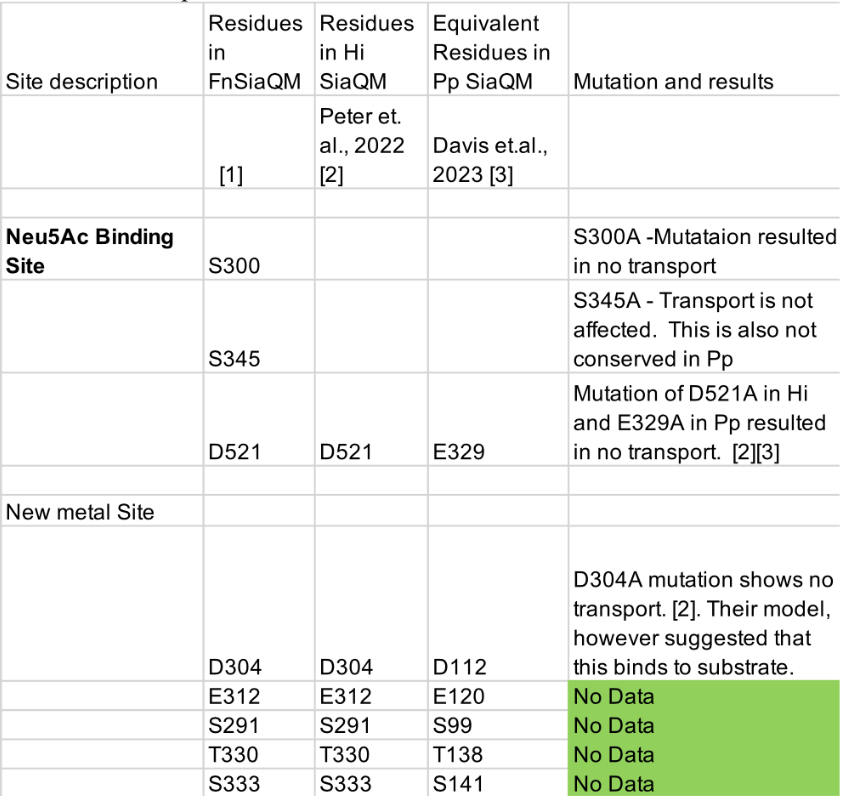Peer review process
Not revised: This Reviewed Preprint includes the authors’ original preprint (without revision), an eLife assessment, public reviews, and a provisional response from the authors.
Read more about eLife’s peer review process.Editors
- Reviewing EditorAndres Jara-OsegueraThe University of Texas at Austin, Austin TX, United States of America
- Senior EditorMerritt MadukeStanford University, Stanford, United States of America
Reviewer #1 (Public Review):
Summary:
This manuscript reports the substrate-bound structure of SiaQM from F. nucleatum, which is the membrane component of a Neu5Ac-specific Tripartite ATP-dependent Periplasmic (TRAP) transporter. Until recently, there was no experimentally derived structural information regarding the membrane components of the TRAP transporter, limiting our understanding of the transport mechanism. Since 2022, there have been 3 different studies reporting the structures of the membrane components of Neu5Ac-specific TRAP transporters. While it was possible to narrow down the binding site location by comparing the structures to proteins of the same fold, a structure with substrate bound has been missing. In this work, the authors report the Na+-bound state and the Na+ plus Neu5Ac state of FnSiaQM, revealing information regarding substrate coordination. In previous studies, 2 Na+ ion sites were identified. Here, the authors also tentatively assign a 3rd Na+ site. The authors reconstitute the transporter to assess the effects of mutating the binding site residues they identified in their structures. Of the 2 positions tested, only one of them appears to be critical to substrate binding.
Strengths:
The main strength of this work is the capture of the substrate-bound state of SiaQM, which provides insight into an important part of the transport cycle.
Weaknesses:
The main weakness is the lack of experimental validation of the structural findings. The authors identified the Neu5Ac binding site, but only tested 2 residues for their involvement in substrate interactions, which was very limited. The authors tentatively identified a 3rd Na+ binding site, which if true would be an impactful finding, but this site was not tested for its contribution to Na+ dependent transport, and the authors themselves report that the structural evidence is not wholly convincing. This lack of experimental validation undermines the confidence of the findings. However, the reporting of these new data is important as it will facilitate follow-up studies by the authors or other researchers.
Reviewer #2 (Public Review):
In this exciting new paper from the Ramaswamy group at Purdue, the authors provide a new structure of the membrane domains of a tripartite ATP-independent periplasmic (TRAP) transporter for the important sugar acid, N-acetylneuraminic acid or sialic acid (Neu5Ac). While there have been a number of other structures in the last couple of years (the first for any TRAP-T) this is the first to trap the structure with Neu5Ac bound to the membrane domains. This is an important breakthrough as in this system the ligand is delivered by a substrate-binding protein (SBP), in this case, called SiaP, where Neu5Ac binding is well studied but the 'hand over' to the membrane component is not clear. The structure of the membrane domains, SiaQM, revealed strong similarities to other SBP-independent Na+-dependent carriers that use an elevator mechanism and have defined Na+ and ligand binding sites. Here they solve the cryo-EM structure of the protein from the bacterial oral pathogen Fusobacterium nucleatum and identify a potential third (and theoretically predicted) Na+ binding site but also locate for the first time the Neu5Ac binding site. While this sits in a region of the protein that one might expect it to sit, based on comparison to other transporters like VcINDY, it provides the first molecular details of the binding site architecture and identifies a key role for Ser300 in the transport process, which their structure suggests coordinates the carboxylate group of Neu5Ac. The work also uses biochemical methods to confirm the transporter from F. nucleatum is active and similar to those used by selected other human and animal pathogens and now provides a framework for the design of inhibitors of these systems.
The strengths of the paper lie in the locating of Neu5Ac bound to SiaQM, providing important new information on how TRAP transporters function. The complementary biochemical analysis also confirms that this is not an atypical system and that the results are likely true for all sialic acid-specific TRAP systems.
The main weakness is the lack of follow-up on the identified binding site in terms of structure-function analysis. While Ser300 is shown to be important, only one other residue is mutated and a much more extensive analysis of the newly identified binding site would have been useful.
Reviewer #3 (Public Review):
The manuscript by Goyal et al reports substrate-bound and substrate-free structures of a tripartite ATP-independent periplasmic (TRAP) transporter from a previously uncharacterized homolog, F. nucleatum. This is one of the most mechanistically fascinating transporter families, by means of its QM domain (the domain reported in his manuscript) operating as a monomeric 'elevator', and its P domain functioning as a substrate-binding 'operator' that is required to deliver the substrate to the QM domain; together, this is termed an 'elevator with an operator' mechanism. Remarkably, previous structures had not demonstrated the substrate Neu5Ac bound. In addition, they confirm the previously reported Na+ binding sites and report a new metal binding site in the transporter, which seems to be mechanistically relevant. Finally, they mutate the substrate binding site and use proteoliposomal uptake assays to show the mechanistic relevance of the proposed substrate binding residues.
The structures are of good quality, the functional data is robust, the text is well-written, and the authors are appropriately careful with their interpretations. Determination of a substrate-bound structure is an important achievement and fills an important gap in the 'elevator with an operator' mechanism. Nevertheless, I have concerns with the data presentation, which in its current state does not intuitively demonstrate the discussed findings. Furthermore, the structural analysis appears limited, and even slight improvements in data processing and resulting resolution would greatly improve the authors' claims. I have several suggestions to hopefully improve the clarity and quality of the manuscript.




